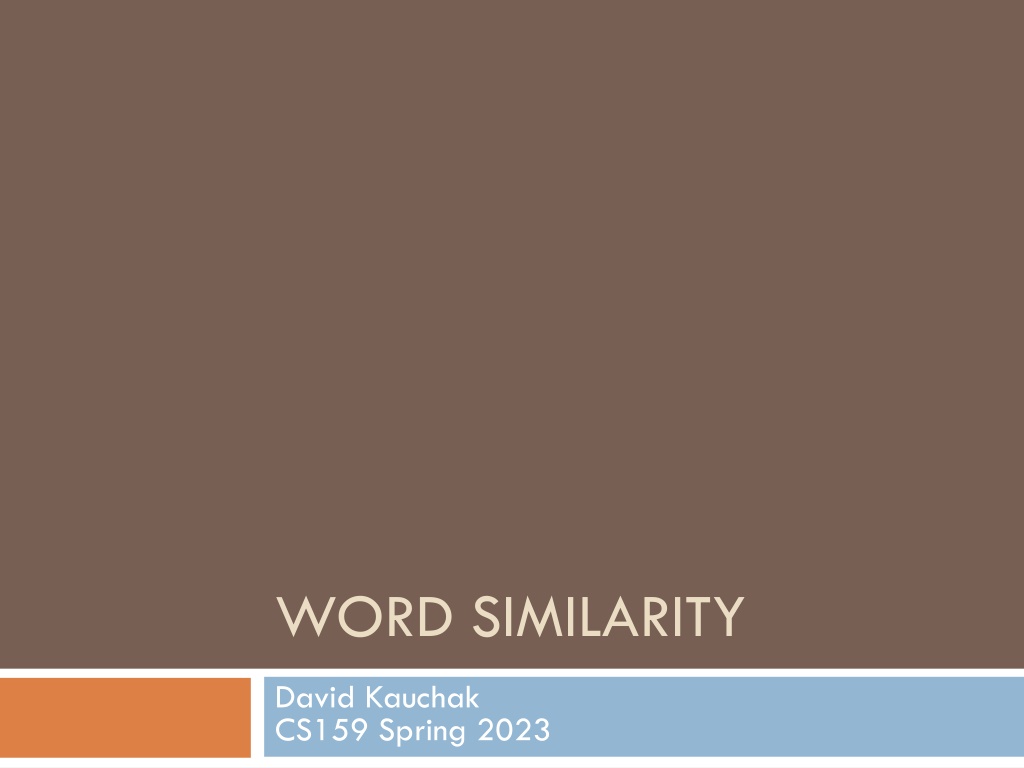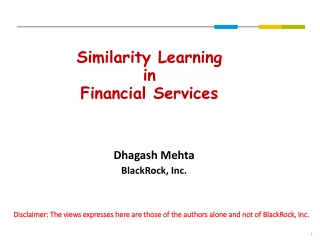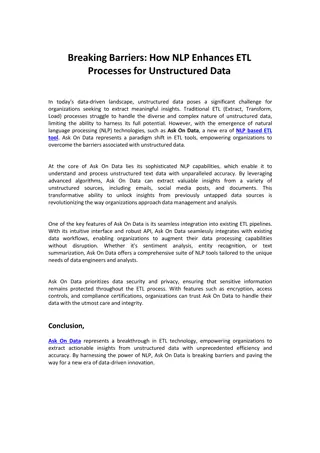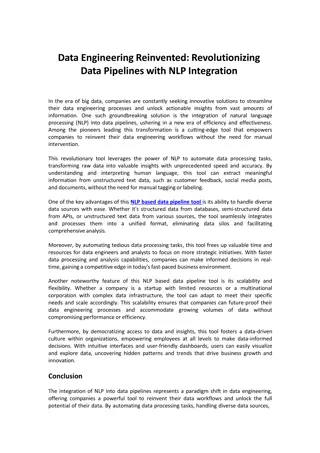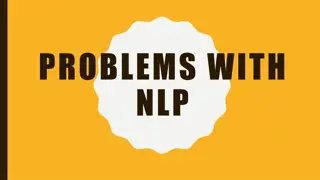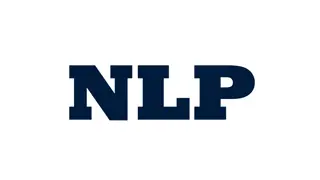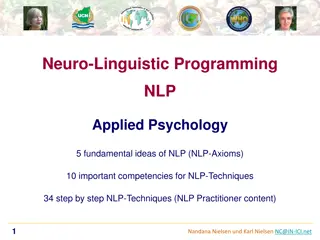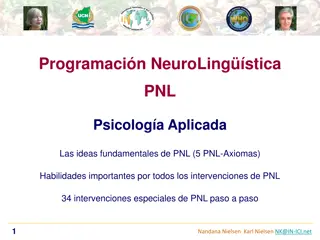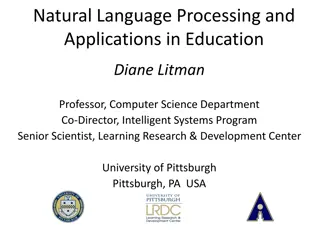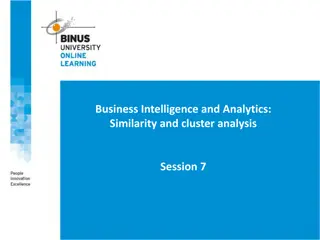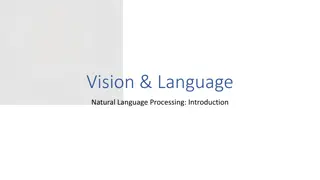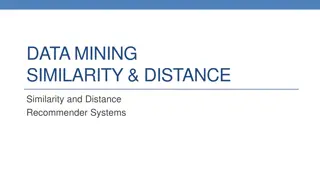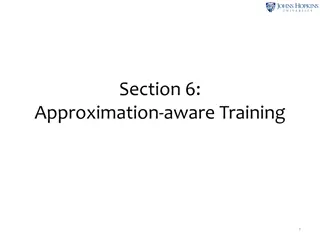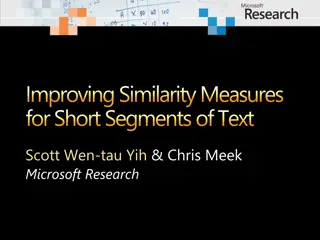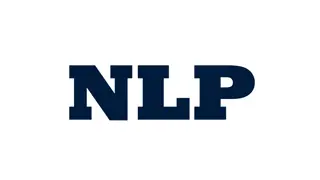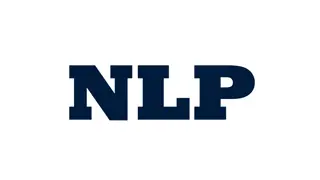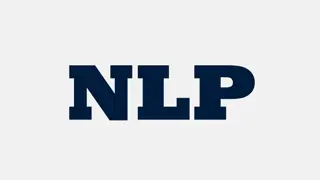Understanding Text Similarity Techniques in NLP
Explore various text similarity techniques in Natural Language Processing (NLP), including word order, length, synonym, spelling, word importance, and word frequency considerations. Topics covered include bag-of-words representation, vector-based word similarities, TF-IDF weighting scheme, normalized distance measures like Cosine similarity, and addressing challenges in creating a model for word similarity.
Uploaded on Sep 28, 2024 | 2 Views
Download Presentation

Please find below an Image/Link to download the presentation.
The content on the website is provided AS IS for your information and personal use only. It may not be sold, licensed, or shared on other websites without obtaining consent from the author. Download presentation by click this link. If you encounter any issues during the download, it is possible that the publisher has removed the file from their server.
E N D
Presentation Transcript
WORD SIMILARITY David Kauchak CS159 Spring 2023
Admin Assignment 4 Quiz #2 Thursday 45 minutes Open book and notes Done with class after that Assignment 5 Two part assignment A due before spring break Have a proper spring break! B due a week after spring break
Quiz #2 Topics Linguistics 101 Parsing Grammars, CFGs, PCFGs Top-down vs. bottom-up CKY algorithm Grammar learning Evaluation Improved models Text similarity (conceptual coverage) Will also be covered on Quiz #3, though
Text Similarity A common question in NLP is how similar are texts ) = ? , sim( score: ? rank:
Bag of words representation For now, let s ignore word order: Obama said banana repeatedly last week on tv, banana, banana, banana Bag of words representation : multi-dimensional vector, one dimension per word in our vocabulary (4, 1, 1, 0, 0, 1, 0, 0, ) Frequency of word occurrence
Vector based word A a1: When a2: the a3: defendant a4: and a5: courthouse 1 2 1 1 0 Multi-dimensional vectors, one dimension per word in our vocabulary B b1: When b2: the b3: defendant b4: and b5: courthouse 1 2 1 0 1
TF-IDF One of the most common weighting schemes TF = term frequency IDF = inverse document frequency a i=ai logN/dfi IDF (word importance weight ) TF We can then use this with any of our similarity measures!
Normalized distance measures Cosine n aibi n simcos(A,B) = A B = = i=1 a i b i i=1 n n 2 2 ai bi i=1 i=1 L2 n ( ai- bi)2 distL2(A,B)= i=1 L1 a and b are length normalized versions of the vectors n ai- bi distL1(A,B)= i=1
Our problems Which of these have we addressed? word order length synonym spelling mistakes word importance word frequency A model of word similarity!
Word overlap problems A: When the defendant and his lawyer walked into the court, some of the victim supporters turned their backs to him. B: When the defendant walked into the courthouse with his attorney, the crowd truned their backs on him.
Word similarity How similar are two words? sim(w1, w2) = ? score: w1 w2 w3 applications? w ? rank: list: w1 and w2 are synonyms
Word similarity applications General text similarity Thesaurus generation Automatic evaluation Text-to-text paraphrasing summarization machine translation information retrieval (search)
Word similarity How similar are two words? sim(w1, w2) = ? score: w1 w2 w3 ideas? useful resources? w ? rank: list: w1 and w2 are synonyms
Word similarity Four categories of approaches (maybe more) Character-based turned vs. truned cognates (night, nacht, nicht, natt, nat, noc, noch) Semantic web-based (e.g. WordNet) Dictionary-based Distributional similarity-based similar words occur in similar contexts
Character-based similarity sim(turned, truned) = ? How might we do this using only the words (i.e. no outside resources?
Edit distance (Levenshtein distance) The edit distance between w1 and w2 is the minimum number of operations to transform w1 into w2 Operations: insertion deletion substitution EDIT(turned, truned) = ? EDIT(computer, commuter) = ? EDIT(banana, apple) = ? EDIT(wombat, worcester) = ?
Edit distance EDIT(turned, truned) = 2 delete u insert u EDIT(computer, commuter) = 1 replace p with m EDIT(banana, apple) = 5 delete b replace n with p replace a with p replace n with l replace a with e EDIT(wombat, worcester) = 6
Better edit distance Are all operations equally likely? No Improvement: give different weights to different operations replacing a for e is more likely than z for y Ideas for weightings? Learn from actual data (known typos, known similar words) Intuitions: phonetics Intuitions: keyboard configuration
Vector character-based word similarity sim(turned, truned) = ? Any way to leverage our vector-based similarity approaches from last time?
Vector character-based word similarity sim(turned, truned) = ? Generate a feature vector based on the characters (or could also use the set based measures at the character level) a: 0 b: 0 c: d: 1 e: 1 f: g: 0 a: 0 b: 0 c: d: 1 e: 1 f: g: 0 0 0 0 0 problems?
Vector character-based word similarity sim(restful, fluster) = ? Character level loses a lot of information a: 0 b: 0 c: d: 1 e: 1 f: g: 0 a: 0 b: 0 c: d: 1 e: 1 f: g: 0 0 0 0 0 ideas?
Vector character-based word similarity sim(restful, fluster) = ? Use character bigrams or even trigrams aa: 0 ab: 0 ac: 0 es: 1 fu: 1 re: 1 aa: 0 ab: 0 ac: 0 er: 1 fl: 1 lu: 1
Word similarity Four general categories Character-based turned vs. truned cognates (night, nacht, nicht, natt, nat, noc, noch) Semantic web-based (e.g. WordNet) Dictionary-based Distributional similarity-based similar words occur in similar contexts
WordNet Lexical database for English 155,287 words 206,941 word senses 117,659 synsets (synonym sets) ~400K relations between senses Parts of speech: nouns, verbs, adjectives, adverbs Word graph, with word senses as nodes and edges as relationships Psycholinguistics WN attempts to model human lexical memory Design based on psychological testing Created by researchers at Princeton http://wordnet.princeton.edu/ Lots of programmatic interfaces
WordNet relations synonym antonym hypernyms hyponyms holonym meronym troponym entailment (and a few others)
WordNet relations synonym X and Y have similar meaning antonym X and Y have opposite meanings hypernyms subclass beagle is a hypernym of dog hyponyms superclass dog is a hyponym of beagle holonym contains part car is a holonym of wheel meronym part of wheel is a meronym of car
WordNet relations troponym for verbs, a more specific way of doing an action run is a troponym of move dice is a troponym of cut entailment for verbs, one activity leads to the next sleep is entailed by snore (and a few others)
WordNet Graph, where nodes are words and edges are relationships There is some hierarchical information, for example with hyp-er/o-nomy
WordNet-like Hierarchy animal fish mammal reptile amphibian horse cat wolf dog mare stallion hunting dog dachshund terrier To utilize WordNet, we often want to think about some graph- based measure.
WordNet-like Hierarchy animal fish mammal reptile amphibian horse cat wolf dog mare stallion hunting dog dachshund terrier Rank the following based on similarity: SIM(wolf, dog) SIM(wolf, amphibian) SIM(terrier, wolf) SIM(dachshund, terrier)
WordNet-like Hierarchy animal fish mammal reptile amphibian horse cat wolf dog SIM(dachshund, terrier) SIM(wolf, dog) SIM(terrier, wolf) SIM(wolf, amphibian) mare stallion hunting dog dachshund terrier What information/heuristics did you use to rank these?
WordNet-like Hierarchy animal fish mammal reptile amphibian horse cat wolf dog SIM(dachshund, terrier) SIM(wolf, dog) SIM(terrier, wolf) SIM(wolf, amphibian) mare stallion hunting dog dachshund terrier - path length is important (but not the only thing) - words that share the same ancestor are related - words lower down in the hierarchy are finer grained and therefore closer
WordNet similarity measures path length doesn t work very well Some ideas: path length scaled by the depth (Leacock and Chodorow, 1998) With a little cheating: Measure the information content of a word using a corpus: how specific is a word? words higher up tend to have less information content more frequent words (and ancestors of more frequent words) tend to have less information content
WordNet similarity measures Utilizing information content: information content of the lowest common parent (Resnik, 1995) information content of the words minus information content of the lowest common parent (Jiang and Conrath, 1997) information content of the lowest common parent divided by the information content of the words (Lin, 1998)
Word similarity Four general categories Character-based turned vs. truned cognates (night, nacht, nicht, natt, nat, noc, noch) Semantic web-based (e.g. WordNet) Dictionary-based Distributional similarity-based similar words occur in similar contexts
Dictionary-based similarity Word Dictionary blurb a large, nocturnal, burrowing mammal, Orycteropus afer, ofcentral and southern Africa, feeding on ants and termites andhaving a long, extensile tongue, strong claws, and long ears. aardvark One of a breed of small hounds having long ears, short legs, and a usually black, tan, and white coat. beagle Any carnivore of the family Canidae, having prominent canine teeth and, in the wild state, a long and slender muzzle, a deep-chested muscular body, a bushy tail, and large, erect ears. Compare canid. dog
Dictionary-based similarity Utilize our text similarity measures sim(dog, beagle) = One of a breed of small hounds having long ears, short legs, and a usually black, tan, and sim( , white coat. Any carnivore of the family Canidae, having prominent canine teeth and, in the wild state, a long and slender muzzle, a deep-chested muscular body, a bushy tail, and large, erect ears. Compare canid. )
Dictionary-based similarity What about words that have multiple senses/parts of speech?
Dictionary-based similarity 1. part of speech tagging 2. word sense disambiguation 3. most frequent sense 4. average similarity between all senses 5. max similarity between all senses 6. sum of similarity between all senses
Dictionary + WordNet WordNet also includes a gloss similar to a dictionary definition Other variants include the overlap of the word senses as well as those word senses that are related (e.g. hypernym, hyponym, etc.) incorporates some of the path information as well Banerjee and Pedersen, 2003
Word similarity Four general categories Character-based turned vs. truned cognates (night, nacht, nicht, natt, nat, noc, noch) Semantic web-based (e.g. WordNet) Dictionary-based Distributional similarity-based similar words occur in similar contexts
Corpus-based approaches Word ANY blurb with the word aardvark Ideas? beagle dog
Corpus-based The Beagle is a breed of small to medium-sized dog. A member of the Hound Group, it is similar in appearance to the Foxhound but smaller, with shorter leg Beagles are intelligent, and are popular as pets because of their size, even temper, and lack of inherited health problems. Dogs of similar size and purpose to the modern Beagle can be traced in Ancient Greece[2] back to around the 5th century BC. From medieval times, beagle was used as a generic description for the smaller hounds, though these dogs differed considerably from the modern breed. In the 1840s, a standard Beagle type was beginning to develop: the distinction between the North Country Beagle and Southern
Corpus-based: feature extraction The Beagle is a breed of small to medium-sized dog. A member of the Hound Group, it is similar in appearance to the Foxhound but smaller, with shorter leg We d like to utilize our vector-based approach How could we we create a vector from these occurrences? collect word counts from all documents with the word in it collect word counts from all sentences with the word in it collect all word counts from all words within X words of the word collect all words counts from words in specific relationship: subject- object, etc.
Word-context co-occurrence vectors The Beagle is a breed of small to medium-sized dog. A member of the Hound Group, it is similar in appearance to the Foxhound but smaller, with shorter leg Beagles are intelligent, and are popular as pets because of their size, even temper, and lack of inherited health problems. Dogs of similar size and purpose to the modern Beagle can be traced in Ancient Greece[2] back to around the 5th century BC. From medieval times, beagle was used as a generic description for the smaller hounds, though these dogs differed considerably from the modern breed. In the 1840s, a standard Beagle type was beginning to develop: the distinction between the North Country Beagle and Southern
Word-context co-occurrence vectors The Beagle is a breed the: is: a: breed: are: intelligent: and: to: modern: 2 1 2 1 1 1 1 1 1 Beagles are intelligent, and to the modern Beagle can be traced From medieval times, beagle was used as 1840s, a standard Beagle type was beginning Often do some preprocessing like lowercasing and removing stop words
Corpus-based similarity sim(dog, beagle) = sim(context_vector(dog), context_vector(beagle)) the: is: a: breeds: are: intelligent: 5 1 4 2 1 5 the: is: a: breed: are: intelligent: and: to: modern: 2 1 2 1 1 1 1 1 1
Web-based similarity Ideas?
